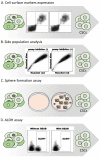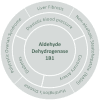The Concept of Cancer Stem Cells: Elaborating on ALDH1B1 as an Emerging Marker of Cancer Progression
- PMID: 36676146
- PMCID: PMC9863106
- DOI: 10.3390/life13010197
The Concept of Cancer Stem Cells: Elaborating on ALDH1B1 as an Emerging Marker of Cancer Progression
Abstract
Cancer is a multifactorial, complex disease exhibiting extraordinary phenotypic plasticity and diversity. One of the greatest challenges in cancer treatment is intratumoral heterogeneity, which obstructs the efficient eradication of the tumor. Tumor heterogeneity is often associated with the presence of cancer stem cells (CSCs), a cancer cell sub-population possessing a panel of stem-like properties, such as a self-renewal ability and multipotency potential. CSCs are associated with enhanced chemoresistance due to the enhanced efflux of chemotherapeutic agents and the existence of powerful antioxidant and DNA damage repair mechanisms. The distinctive characteristics of CSCs make them ideal targets for clinical therapeutic approaches, and the identification of efficient and specific CSCs biomarkers is of utmost importance. Aldehyde dehydrogenases (ALDHs) comprise a wide superfamily of metabolic enzymes that, over the last years, have gained increasing attention due to their association with stem-related features in a wide panel of hematopoietic malignancies and solid cancers. Aldehyde dehydrogenase 1B1 (ALDH1B1) is an isoform that has been characterized as a marker of colon cancer progression, while various studies suggest its importance in additional malignancies. Here, we review the basic concepts related to CSCs and discuss the potential role of ALDH1B1 in cancer development and its contribution to the CSC phenotype.
Keywords: ALDHs; CSCs; aldehyde dehydrogenase 1B1; aldehyde dehydrogenases; cancer; cancer stem cells.
Conflict of interest statement
The authors declare no conflict of interest.
Figures








Similar articles
-
Exploring the Role and Pathophysiological Significance of Aldehyde Dehydrogenase 1B1 (ALDH1B1) in Human Lung Adenocarcinoma.Int J Mol Sci. 2024 Sep 25;25(19):10301. doi: 10.3390/ijms251910301. Int J Mol Sci. 2024. PMID: 39408636 Free PMC article.
-
Aldehyde dehydrogenase 1B1 (ALDH1B1) is a potential biomarker for human colon cancer.Biochem Biophys Res Commun. 2011 Feb 11;405(2):173-9. doi: 10.1016/j.bbrc.2011.01.002. Epub 2011 Jan 7. Biochem Biophys Res Commun. 2011. PMID: 21216231 Free PMC article.
-
Aldehyde Dehydrogenase 1B1 Is Associated with Altered Cell Morphology, Proliferation, Migration and Chemosensitivity in Human Colorectal Adenocarcinoma Cells.Biomedicines. 2021 Jan 6;9(1):44. doi: 10.3390/biomedicines9010044. Biomedicines. 2021. PMID: 33419031 Free PMC article.
-
The Multifaceted Role of Aldehyde Dehydrogenases in Prostate Cancer Stem Cells.Cancers (Basel). 2021 Sep 20;13(18):4703. doi: 10.3390/cancers13184703. Cancers (Basel). 2021. PMID: 34572930 Free PMC article. Review.
-
Targeting Aldehyde Dehydrogenases to Eliminate Cancer Stem Cells in Gynecologic Malignancies.Cancers (Basel). 2020 Apr 13;12(4):961. doi: 10.3390/cancers12040961. Cancers (Basel). 2020. PMID: 32295073 Free PMC article. Review.
Cited by
-
The Impact of Cancer Stem Cells in Colorectal Cancer.Int J Mol Sci. 2024 Apr 9;25(8):4140. doi: 10.3390/ijms25084140. Int J Mol Sci. 2024. PMID: 38673727 Free PMC article. Review.
-
Identification and validation of glucose metabolism-related gene signature in endometrial cancer.BMC Cancer. 2025 Jan 7;25(1):30. doi: 10.1186/s12885-024-13418-9. BMC Cancer. 2025. PMID: 39773448 Free PMC article.
-
Human Aldehyde Dehydrogenases: A Superfamily of Similar Yet Different Proteins Highly Related to Cancer.Cancers (Basel). 2023 Sep 4;15(17):4419. doi: 10.3390/cancers15174419. Cancers (Basel). 2023. PMID: 37686694 Free PMC article. Review.
-
Cancer stem cells: an insight into the development of metastatic tumors and therapy resistance.Stem Cell Rev Rep. 2023 Aug;19(6):1577-1595. doi: 10.1007/s12015-023-10529-x. Epub 2023 May 2. Stem Cell Rev Rep. 2023. PMID: 37129728 Review.
-
Aldehyde Dehydrogenase-1A1 (ALDH1A1): The Novel Regulator of Chemoresistance in Pancreatic Cancer Cells.Cancer Control. 2024 Jan-Dec;31:10732748241305835. doi: 10.1177/10732748241305835. Cancer Control. 2024. PMID: 39611960 Free PMC article. Review.
References
-
- Hanahan D. Hallmarks of Cancer: New Dimensions. Cancer Discov. 2022;12:31–46. doi: 10.1158/2159-8290.CD-21-1059. - DOI - PubMed
Publication types
LinkOut - more resources
Full Text Sources

